Continuous positive airway pressure (CPAP) for acute bronchiolitis in children
- PMID: 35377462
- PMCID: PMC8978604
- DOI: 10.1002/14651858.CD010473.pub4
Continuous positive airway pressure (CPAP) for acute bronchiolitis in children
Abstract
Background: Acute bronchiolitis is one of the most frequent causes of emergency department visits and hospitalisation in children up to three years of age. There is no specific treatment for bronchiolitis except for supportive treatment, which includes ensuring adequate hydration and oxygen supplementation. Continuous positive airway pressure (CPAP) aims to widen the lungs' peripheral airways, enabling deflation of overdistended lungs in bronchiolitis. Increased airway pressure also prevents the collapse of poorly supported peripheral small airways during expiration. Observational studies report that CPAP is beneficial for children with acute bronchiolitis. This is an update of a review first published in 2015 and updated in 2019.
Objectives: To assess the efficacy and safety of CPAP compared to no CPAP or sham CPAP in infants and children up to three years of age with acute bronchiolitis.
Search methods: We conducted searches of CENTRAL (2021, Issue 7), which includes the Cochrane Acute Respiratory Infections Group Specialised Register, MEDLINE (1946 to August 2021), Embase (1974 to August 2021), CINAHL (1981 to August 2021), and LILACS (1982 to August 2021) in August 2021. We also searched the US National Institutes of Health Ongoing Trials Register ClinicalTrials.gov and the World Health Organization (WHO) International Clinical Trials Registry Platform (ICTRP) for completed and ongoing trials on 26 October 2021.
Selection criteria: We considered randomised controlled trials (RCTs), quasi-RCTs, cross-over RCTs, and cluster-RCTs evaluating the effect of CPAP in children with acute bronchiolitis.
Data collection and analysis: Two review authors independently assessed study eligibility, extracted data using a structured pro forma, analysed data, and performed meta-analyses. We used the Cochrane risk of bias tool to assess risk of bias in the included studies. We created a summary of the findings table employing GRADEpro GDT software. MAIN RESULTS: We included three studies with a total of 122 children (62/60 in intervention/control arms) aged up to 12 months investigating nasal CPAP compared with supportive (or 'standard') therapy. We included one new trial (72 children) in the 2019 update that contributed data to the assessment of respiratory rate and the need for mechanical ventilation for this update. We did not identify any new trials for inclusion in the current update. The included studies were single-centre trials conducted in France, the UK, and India. Two studies were parallel-group RCTs, and one study was a cross-over RCT. The evidence provided by the included studies was of low certainty; we made an assessment of high risk of bias for blinding, incomplete outcome data, and selective reporting, and confidence intervals were wide. The effect of CPAP on the need for mechanical ventilation in children with acute bronchiolitis was uncertain due to risk of bias and imprecision around the effect estimate (risk difference -0.01, 95% confidence interval (CI) -0.09 to 0.08; 3 RCTs, 122 children; low certainty evidence). None of the trials measured time to recovery. Limited, low certainty evidence indicated that CPAP decreased respiratory rate (decreased respiratory rate is better) (mean difference (MD) -3.81, 95% CI -5.78 to -1.84; 2 RCTs, 91 children; low certainty evidence). Only one trial measured change in arterial oxygen saturation (increased oxygen saturation is better), and the results were imprecise (MD -1.70%, 95% CI -3.76 to 0.36; 1 RCT, 19 children; low certainty evidence). The effect of CPAP on change in arterial partial carbon dioxide pressure (pCO₂) (decrease in pCO₂ is better) was imprecise (MD -2.62 mmHg, 95% CI -5.29 to 0.05; 2 RCTs, 50 children; low certainty evidence). Duration of hospital stay was similar in both the CPAP and supportive care groups (MD 0.07 days, 95% CI -0.36 to 0.50; 2 RCTs, 50 children; low certainty evidence). Two studies did not report pneumothorax, but pneumothorax did not occur in one study. No studies reported occurrences of deaths. Several outcomes (change in partial oxygen pressure, hospital admission rate (from the emergency department to hospital), duration of emergency department stay, and need for intensive care unit admission) were not reported in the included studies.
Authors' conclusions: The use of CPAP did not reduce the need for mechanical ventilation in children with bronchiolitis, although the evidence was of low certainty. Limited, low certainty evidence suggests that breathing improved (a decreased respiratory rate) in children with bronchiolitis who received CPAP; this finding is unchanged from the 2015 review and 2019 update. Due to the limited available evidence, the effect of CPAP in children with acute bronchiolitis is uncertain for our other outcomes. Larger, adequately powered trials are needed to evaluate the effect of CPAP for children with acute bronchiolitis.
Copyright © 2022 The Cochrane Collaboration. Published by John Wiley & Sons, Ltd.
Conflict of interest statement
Kana R Jat: declared that they have no conflict of interest. Jeanne M Dsouza: declared that they have no conflict of interest. Joseph L Mathew: declared that they have no conflict of interest.
Figures
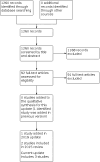
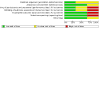

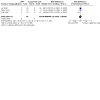
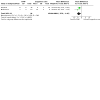


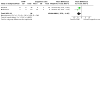
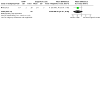
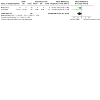
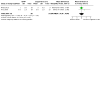
Update of
-
Continuous positive airway pressure (CPAP) for acute bronchiolitis in children.Cochrane Database Syst Rev. 2019 Jan 31;1(1):CD010473. doi: 10.1002/14651858.CD010473.pub3. Cochrane Database Syst Rev. 2019. Update in: Cochrane Database Syst Rev. 2022 Apr 4;4:CD010473. doi: 10.1002/14651858.CD010473.pub4. PMID: 30701528 Free PMC article. Updated.
References
References to studies included in this review
Lal 2018 {published data only}
-
- Lal SN, Kaur J, Anthwal P, Goyal K, Bahl P, Puliyel JM.Nasal continuous positive airway pressure in bronchiolitis: a randomized controlled trial. Indian Pediatrics 2018;55(1):27-30. - PubMed
Milési 2013 {published data only}
-
- Milési C, Matecki S, Jaber S, Mura T, Jacquot A, Pidoux O, et al.6 cm H₂O continuous positive airway pressure versus conventional oxygen therapy in severe viral bronchiolitis: a randomized trial. Pediatric Pulmonology 2013;48(1):45-51. - PubMed
Thia 2008 {published data only}
-
- Thia LP, McKenzie SA, Blyth TP, Minasian CC, Kozlowska WJ, Carr SB.Randomised controlled trial of nasal continuous positive airways pressure (CPAP) in bronchiolitis. Archives of Disease in Childhood 2008;93(1):45-7. - PubMed
References to studies excluded from this review
Balanzat 2006 {published data only}
-
- Balanzat AM, Lazarte G, Surarez V, Bonilla ME, Gighi M, Chede C, et al.Effects of different levels of nasal continuous positive airways pressure (CPAP) in infants with severe acute bronchiolitis. European Respiratory Journal 2006;28(Suppl 50):P1531.
Cesar 2017 {published data only}
-
- Cesar R, Bispo B, Felix PH, Modolo MC, Cabo S, Souza A, et al.A randomized controlled trial of high-flow nasal cannula versus CPAP in critical bronchiolitis. Critical Care Medicine 2017;46(1):553.
Chidini 2011 {published data only}
-
- Chidini G, Piastra M, Wolfler A, Marchesi T, Calderini E, Conti G, et al.Noninvasive continuous positive airway pressure (NCPAP) by helmet versus facial mask: a multicenter RCT. Intensive Care Medicine 2011;135(Suppl 2):331-2.
Chidini 2015 {published data only}
-
- Chidini G, Piastra M, Marchesi T, De Luca D, Napolitano L, Salvo I, et al.Continuous positive airway pressure with helmet versus mask in infants with bronchiolitis: an RCT. Pediatrics 2015;135(4):e868-75. - PubMed
Hough 2011 {published data only}
-
- Hough JL, Pham TM, Schibler A.Delivery of high flow nasal prong oxygen: the effect CPAP exposed. Pediatric Critical Care Medicine 2011;12(Suppl):A7.
Javouhey 2008 {published data only}
-
- Javouhey E, Barats A, Richard N, Stamm D, Floret D.Non-invasive ventilation as primary ventilatory support for infants with severe bronchiolitis. Intensive Care Medicine 2008;34(9):1608-14. - PubMed
Milési 2017 {published data only}
-
- Milési C, Essouri S, Pouyau R, Liet JM, Afanetti M, Portefaix A, et al.High flow nasal cannula (HFNC) versus nasal continuous positive airway pressure (nCPAP) for the initial respiratory management of acute viral bronchiolitis in young infants: a multicenter randomized controlled trial (TRAMONTANE study). Intensive Care Medicine 2017;43(2):209-16. - PubMed
Smith 1993 {published data only}
-
- Smith PG, el-Khatib MF, Carlo WA.PEEP does not improve pulmonary mechanics in infants with bronchiolitis. American Review of Respiratory Disease 1993;147(5):1295-8. - PubMed
Yañez 2008 {published data only}
-
- Yañez LJ, Yunge M, Emilfork M, Lapadula M, Alcántara A, Fernández C, et al.A prospective, randomized, controlled trial of noninvasive ventilation in pediatric acute respiratory failure. Pediatric Critical Care Medicine 2008;9(5):484-9. - PubMed
References to ongoing studies
Arya 2020 {unpublished data only}
-
- CTRI/2020/06/026071.Continuous positive airway pressure (CPAP) and standard therapy in children with bronchiolitis - a comparative study. trialsearch.who.int/Trial2.aspx?TrialID=CTRI/2020/06/026071 (first received 23 June 2020).
Additional references
Atkins 2004
Beggs 2014
Bont 2009
-
- Bont L.Current concepts of the pathogenesis of RSV bronchiolitis. Advances in Experimental Medicine and Biology 2009;634:31-40. - PubMed
Cambonie 2008
-
- Cambonie G, Milési C, Jaber S, Amsallem F, Barbotte E, Picaud JC, et al.Nasal continuous positive airway pressure decreases respiratory muscles overload in young infants with severe acute viral bronchiolitis. Intensive Care Medicine 2008;34(10):1865-72. - PubMed
CDC 2018
-
- Centers for Disease Control and Prevention.Respiratory syncytial virus. www.cdc.gov/rsv/index.html (accessed prior to 21 January 2019).
de Bie 2002
Donlan 2011
-
- Donlan M, Fontela PS, Puligandla PS.Use of continuous positive airway pressure (CPAP) in acute viral bronchiolitis: a systematic review. Pediatric Pulmonology 2011;46(8):736-46. - PubMed
Essouri 2011
-
- Essouri S, Durand P, Chevret L, Balu L, Devictor D, Fauroux B, et al.Optimal level of nasal continuous positive airway pressure in severe viral bronchiolitis. Intensive Care Medicine 2011;37(12):2002-7. - PubMed
Farley 2014
Fernandes 2013
Florin 2017
Gadomski 2014
GRADEpro GDT [Computer program]
-
- GRADEpro GDT.Version accessed 28 June 2018. Hamilton (ON): McMaster University (developed by Evidence Prime). Available at gradepro.org.
Guo 2018
Gupta 2016
-
- Gupta S, Donn SM.Continuous positive airway pressure: physiology and comparison of devices. Seminars in Fetal & Neonatal Medicine 2016;21(3):204-11. - PubMed
Hartling 2011a
Hartling 2011b
Hasegawa 2014
Higgins 2021
-
- Higgins JP, Thomas J, Chandler J, Cumpston M, Li T, Page MJ, Welch VA, editor(s).Cochrane Handbook for Systematic Reviews of Interventions Version 6.2 (updated February 2021). Cochrane, 2021. Available from training.cochrane.org/handbook.
Kabir 2003
-
- Kabir ML, Haq N, Hoque M, Ahmed F, Amin R, Hossain A, et al.Evaluation of hospitalized infants and young children with bronchiolitis - a multi centre study. Mymensingh Medical Journal 2003;12(2):128-33. - PubMed
Kiciman 1998
-
- Kiciman NM, Andréasson B, Bernstein G, Mannino FL, Rich W, Henderson C, et al.Thoracoabdominal motion in newborns during ventilation delivered by endotracheal tube or nasal prongs. Pediatric Pulmonology 1998;25(3):175-81. - PubMed
Krilov 2017
-
- Krilov LR, Fergie J, Goldstein M, McLaurin KK, Wade S, Diakun D, et al.National bronchiolitis hospitalization rates among preterm and full term infants: 2010–2015. Open Forum Infectious Disease 2017;4(Suppl 1):695.
Lanari 2015
Larrar 2006
-
- Larrar S, Essouri S, Durand P, Chevret L, Haas V, Chabernaud JL, et al.Effects of nasal continuous positive airway pressure ventilation in infants with severe acute bronchiolitis. Archives of Pediatrics 2006;13(11):1397-403. - PubMed
Lee 2002
-
- Lee SY, Lopez V.Physiological effects of two temperature settings in preterm infants on nasal continuous airway pressure ventilation. Journal of Clinical Nursing 2002;11(6):845-7. - PubMed
Lefebvre 2021
-
- Lefebvre C, Glanville J, Briscoe S, Littlewood A, Marshall C, Metzendorf M-I, et al.Chapter 4: Searching for and selecting studies. In: Higgins JP, Thomas J, Chandler J, Cumpston M, Li T, Page MJ, Welch VA, editor(s). Cochrane Handbook for Systematic Reviews of Interventions Version 6.2 (updated February 2021). Cochrane, 2021. Available from training.cochrane.org/handbook.
Levy 1997
-
- Levy BT, Graber MA.Respiratory syncytial virus infection in infants and young children. Journal of Family Practice 1997;45(6):473-81. - PubMed
Liet 2015
McNamara 1997
-
- McNamara F, Sullivan CE.Nasal CPAP treatment in an infant with respiratory syncytial virus-associated apnea. Pediatric Pulmonology 1997;24(3):218-21. - PubMed
Meates‐Dennis 2005
-
- Meates-Dennis M.Bronchiolitis. Archives of Disease in Childhood. Education and Practice Edition 2005;90(4):ep81-6.
Merkus 2001
-
- Merkus PJ, Hoog M, Gent R, Jongste JC.DNase treatment for atelectasis in infants with severe respiratory syncytial virus bronchiolitis. European Respiratory Journal 2001;18(4):734-7. - PubMed
Nasr 2001
-
- Nasr SZ, Strouse PJ, Soskolne E, Maxvold NJ, Garver KA, Rubin BK, et al.Efficacy of recombinant human deoxyribonuclease I in the hospital management of respiratory syncytial virus bronchiolitis. Chest 2001;120(1):203-8. - PubMed
NICE 2021
-
- National Institute for Health and Care Excellence.Bronchiolitis in children: diagnosis and management. NICE guideline [NG9]. www.nice.org.uk/guidance/ng9 (accessed 29 October 2021). - PubMed
Oakley 2017
-
- Oakley E, Chong V, Borland M, Neutze J, Phillips N, Krieser D, et al.Intensive care unit admissions and ventilation support in infants with bronchiolitis. Emergency Medicine Australasia 2017;29(4):421-8. - PubMed
Praznik 2018
RevMan Web 2020 [Computer program]
-
- Review Manager Web (RevMan Web).Version 1.22.0. The Cochrane Collaboration, 2020. Available at revman.cochrane.org.
Rivera‐Sepulveda 2017
Robertson 1996
Roqué i Figuls 2016
Scheltema 2017
Soong 1993
-
- Soong WJ, Hwang B, Tang RB.Continuous positive airway pressure by nasal prongs in bronchiolitis. Pediatric Pulmonology 1993;16(3):163-6. - PubMed
Umoren 2011
References to other published versions of this review
Jat 2013
Jat 2015
Publication types
MeSH terms
Substances
LinkOut - more resources
Full Text Sources

